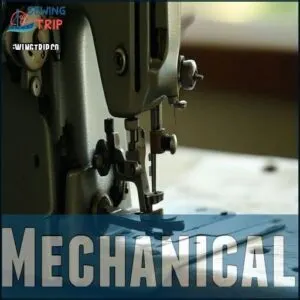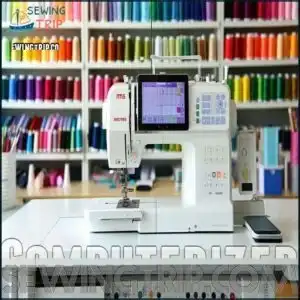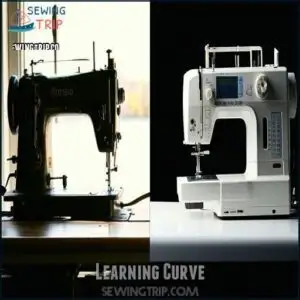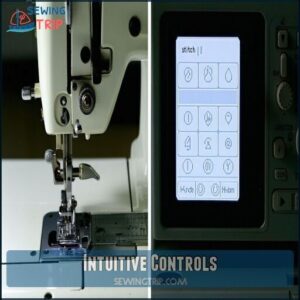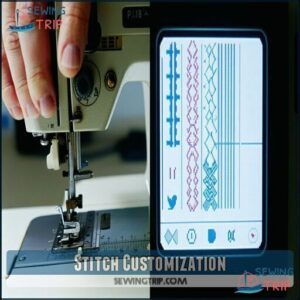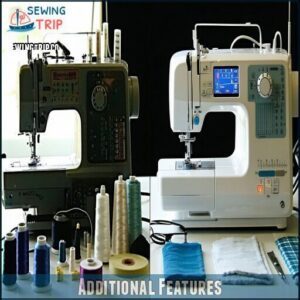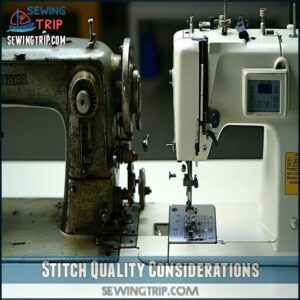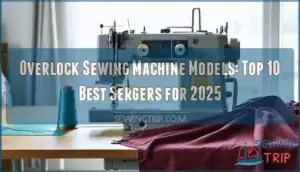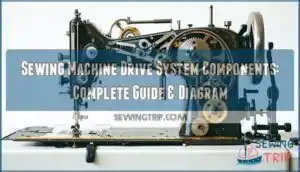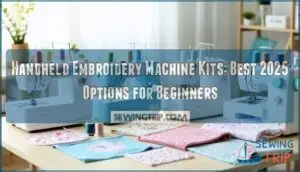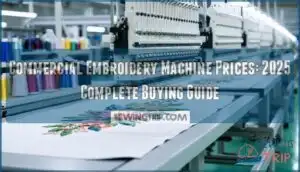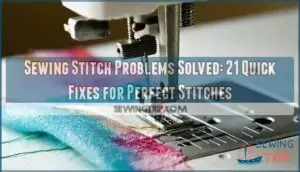This site is supported by our readers. We may earn a commission, at no cost to you, if you purchase through links.
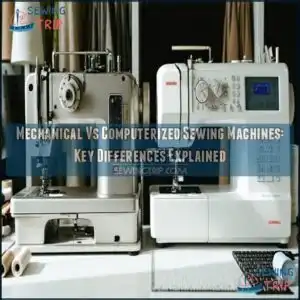 Choosing between mechanical and computerized sewing machines depends on your needs.
Choosing between mechanical and computerized sewing machines depends on your needs.
Mechanical machines are simple, durable, and controlled manually—ideal if you prefer hands-on adjustment and straightforward functionality. Think of them as reliable "no-frills" tools.
Computerized machines, on the other hand, are like smart gadgets—they offer programmable stitches, automatic tension control, and features like embroidery. They’re great if you want precision and convenience but can feel a bit intimidating at first.
Mechanical machines suit basic projects, while computerized ones are better for complex designs.
Ultimately, it’s about what makes your sewing journey easier (and more fun) to manage. Ready to decide?
Table Of Contents
Key Takeaways
- Mechanical sewing machines are simple, durable, and great for basic tasks, relying on manual controls like knobs and levers.
- Computerized sewing machines offer advanced features like programmable stitches, automatic tension, and built-in designs, making them ideal for intricate projects.
- You’ll find computerized machines easier for precision and automation, while mechanical ones give you hands-on control and are budget-friendly.
- Choose a mechanical machine if you prefer simplicity and reliability, or a computerized one for versatility and creative possibilities.
Types of Sewing Machines
In the context of sewing machines, you’ve mainly got two options: mechanical or computerized. Each type offers unique features and benefits, making them better suited for specific sewing needs.
Mechanical
Mechanical sewing machines are like the trusty old friends of the sewing world—reliable, straightforward, and easy to work with.
Reliable and straightforward, mechanical sewing machines are the dependable workhorses every beginner and seasoned sewist can count on.
They’re perfect for beginners or anyone looking for durability without breaking the bank.
Here’s why many prefer them:
- Manual Control: Adjust stitch length and tension easily using gears and levers.
- Simple Maintenance: With fewer parts, they’re beginner-friendly and less likely to need costly repairs.
- Affordable Option: Built for durability, these machines handle basic tasks well and are a budget-friendly choice in the mechanical vs computerized debate.
Computerized
When you upgrade to a computerized sewing machine, you’re stepping into a world of convenience and creativity.
With a digital interface at your fingertips, you can navigate its features effortlessly, even if you’re a bit tech-shy. These machines combine high-tech functionality with precision stitching, perfect for ambitious projects like quilting or intricate embroidery.
Here’s what sets computerized models apart:
- Automatic functions like thread cutting and needle positioning save time and reduce mistakes.
- Precision control guarantees every stitch is perfectly placed, no matter the fabric.
- With software updates, your machine stays modern and ready for new designs.
Many models also offer a buttonhole sensor system for consistent results. Whether it’s versatility or ease, a computerized machine impresses every time.
Ease of Use
In terms of ease of use, mechanical sewing machines are straightforward, with simple knobs and levers that feel familiar.
Computerized machines, on the other hand, might take more time to learn but offer intuitive digital controls once you get the hang of them, which can provide a more familiar experience over time.
Learning Curve
Choosing between a mechanical sewing machine and a computerized sewing machine often comes down to your patience with learning and comfort with technology.
For beginners, a mechanical sewing machine is a straightforward choice with minimal beginner difficulty. Its simple knobs and levers make it easy to get started without constantly referencing user manuals.
On the other hand, tackling a computerized sewing machine involves learning feature complexity, but built-in tutorials and automatic settings can speed up skill development over time. Many computerized models also offer automatic needle threading, further simplifying the setup process.
If you’re drawn to tech, computerized models may feel like an initial investment in your growth. Prefer hands-on control? A mechanical machine lets you focus on mastering basics stitch by stitch.
Ultimately, your comfort and goals determine the ease of use when using mechanical vs computerized options.
Intuitive Controls
In the context of controls, the mechanical sewing machine offers dial simplicity that feels like second nature.
Its manual adjustments rely on dials and knobs, making it beginner-friendly and approachable. Selecting stitches is as easy as a twist or a turn!
Here’s what to expect:
- Smooth dials for selecting stitch types or adjusting tension quickly.
- Knobs that let you tweak stitch length and width effortlessly.
- Clear, labeled settings for immediate understanding.
These machines often utilize specific sewing dials for precise stitch selection.
On the flip side, the computerized sewing machine features screen navigation with a sleek computerized interface. While it packs plenty of features, it might feel like learning a new gadget—a bit more effort, but worth it for precision.
Stitch Customization
In the context of stitch customization, mechanical and computerized sewing machines handle things very differently.
You’ll find that mechanical models let you adjust stitches manually, while computerized ones offer a wide variety of patterns with just a few button presses.
Adjustable Settings
Think of sewing machine adjustable settings like a personal toolkit for tailoring your projects. Whether you’re tweaking Tension Adjustment, Needle Position, or Speed Control, mechanical and computerized models handle things differently.
The key features of mechanical and computerized sewing machines can be compared in the following table:
| Feature | Mechanical Sewing Machine | Computerized Sewing Machine |
|---|---|---|
| Tension Adjustment | Manual dials and levers | Automated digital settings |
| Stitch Length Control | Manual knob | Precise digital inputs |
| Speed Control | Foot pedal control | Programmable speed options |
| Needle Positioning | Manual adjustment | Push-button precision |
With a mechanical sewing machine, settings depend on hand-operated dials, giving you complete control—but requiring patience. A computerized sewing machine simplifies fine-tuning with automated tweaks, saving time on intricate fabrics.
Proper sewing involves tension adjustment sewing for ideal stitch quality.
Stitch Variety
Mechanical and computerized sewing machines bring distinct opportunities in terms of stitch options and stitch patterns. A mechanical sewing machine offers simple stitching basics, like straight or zigzag stitches, ideal for straightforward tasks.
On the other hand, a computerized sewing machine takes sewing to the next level with hundreds of stitch functions designed for intricate designs and fabric versatility.
With computerized machines, you can explore:
- A vast library of decorative stitch patterns for creative projects
- Automatic adjustments for delicate or heavy fabrics
- Built-in alphabets for monograms or text designs
- Memory settings to save your favorite sewing machine stitches
- Advanced customization for pattern complexity.
These features expand your project scope, making innovation almost limitless.
You can find resources for various sewing products online.
Additional Features
In terms of extra features, mechanical and computerized sewing machines couldn’t be more different.
From foot controllers to built-in embroidery functions, the choice really depends on what you need for your projects.
Foot Controller
Your foot pedal isn’t just a sewing machine accessory—it’s your speed commander.
Whether you’re stitching delicate silk or tackling tough denim, its pedal sensitivity and foot pedal pressure give you precise speed control.
Mechanical sewing machines use simple pedals, while computerized models often integrate advanced sewing machine technology for smoother responsiveness.
An ergonomic design minimizes leg strain, perfect for long sewing projects.
Check the cord placement to avoid tangling, and keep pedals clean to guarantee they last.
Small tweaks, big impact on machine performance!
Embroidery Function
If embroidery excites you, a computerized sewing machine is tough to beat.
While mechanical sewing machines handle basics well, they can’t match the precision, speed, and creativity options in sewing machine embroidery.
You’ll enjoy automated features that make stitching intricate patterns a breeze, sparing you hours of handwork.
Key embroidery features include:
- Hundreds of built-in embroidery stitches and patterns for various designs.
- Thread compatibility to work seamlessly with complex designs.
- Pattern complexity controls for resizing or combining designs effortlessly.
- Hoop size options to accommodate various project scales.
- Stabilizer recommendations for smoother stitching and fabric handling.
With computerized embroidery, even the most challenging designs feel manageable!
Included Accessories
The accessories that come with your sewing machine can substantially impact your creativity and productivity.
A computerized sewing machine usually offers a treasure trove of extras, like specialty presser feet, needle packs, bobbins included, and sometimes even extension tables or accessory cases.
These tools expand your project horizons.
On the other hand, a mechanical sewing machine sticks to the basics—usually a zipper foot, a buttonhole attachment, and simple tools for everyday use.
When making a mechanical vs computerized sewing machine comparison, don’t overlook these included sewing machine features—they’re not just add-ons but essential companions for your sewing adventures!
Having a good set of must-have sewing tools will greatly improve your sewing experience.
Stitch Quality Considerations
In terms of stitch quality, you’ll notice clear differences between mechanical and computerized sewing machines.
While mechanical machines rely on your steadiness for consistent stitches, computerized models take the guesswork out by offering precision and advanced settings.
Stitch Consistency
In terms of keeping your stitches flawless, a computerized sewing machine takes the lead.
It automatically adjusts tension settings, manages fabric feed, and maintains consistent speed, guaranteeing precise stitch patterns every time.
To enhance your stitching, consider how consistent tension and speed plays a vital role.
- Tension settings auto-adjust for smoother seams.
- Fabric feed stays even for better results.
- Needle quality ensures clean stitching.
- Thread type impacts overall stitch consistency.
Stitch Customization Options
In the context of stitch customization, a computerized sewing machine outshines its mechanical counterpart.
You’ll enjoy flexibility with features like:
- Adjustable stitch length and width for precision.
- Advanced pattern adjustment options, including decorative stitch patterns.
- Automated tension control for flawless results.
While mechanical machines rely on manual dials, computerized ones handle intricate settings effortlessly, keeping your creative process smooth—no guesswork required!
Fabric Handling Capabilities
Wondering how sewing machines handle fabric?
A computerized sewing machine offers amazing control for delicate fabrics and heavy-duty ones alike, with features like tension adjustment and material feed control.
It’s great for tricky, stretchy, or layered materials.
A mechanical sewing machine, though reliable, might falter with fabric thickness variations, making it better for simpler projects and sturdy materials.
Frequently Asked Questions (FAQs)
What is the difference between a mechanical and a computerized sewing machine?
Think of mechanical machines as sturdy bikes and computerized ones as electric scooters.
Mechanical sewing machines are manual and simple, while computerized models bring automation, versatility, and precision, perfect for tackling detailed or creative projects.
What are the pros and cons of computerized and mechanical sewing machines?
Computerized sewing machines offer advanced features, versatility, and precision but can overwhelm beginners and cost more.
Mechanical machines are simpler, durable, and budget-friendly but lack functionality for complex projects like embroidery or quilting.
Choose based on needs!
What is the difference between mechanical and electronic sewing machines?
Mechanical sewing machines are like dependable bicycles, operating with simple knobs and levers.
While electronic machines add sophistication with digital controls for stitch precision and automation.
You’ll trade simplicity for convenience and versatility with electronics.
What are the advantages of a computerized sewing machine?
You’ll love how computerized sewing machines handle complex tasks with precision and ease.
They offer automatic features like thread cutting, customizable stitch patterns, and built-in designs.
Plus, they’re great for tackling embroidery, quilting, and heavy-duty projects.
Are computerized sewing machines difficult to use?
Features, functions, and familiarity can feel overwhelming at first, but most computerized sewing machines are user-friendly.
With a bit of practice, you’ll enjoy their precision, versatility, and time-saving tricks—like having a sewing assistant on standby!
Are sewing machines better than mechanical machines?
It’s not about which type is "better"—it’s about what you need.
Mechanical machines are simple and reliable, while computerized ones offer advanced features.
Choose the one that fits your projects and skill level.
What is a mechanical sewing machine?
Nearly 60% of sewing enthusiasts stick to basic machines like these.
They’re reliable, affordable, and focus on the fundamentals without overcomplicating things.
You’ll control stitches using knobs and levers, making it perfect for simple tasks.
Which is better, a mechanical or computerized sewing machine?
It depends on your needs.
Mechanical machines are great for simplicity and durability, while computerized ones shine for versatility and precision.
Choose what fits your skill level, budget, and the projects you want to tackle, considering your needs for versatility.
What is the advantage of a computerized sewing machine?
A computerized sewing machine makes your life easier with automatic features like thread cutting and stitch adjustment.
It’s perfect for detailed projects, offering precision, versatility, and plenty of creative options at your fingertips, with automatic features that enhance your sewing experience.
What does it mean if a sewing machine is mechanical?
Using a mechanical sewing machine is like driving a classic car—everything is manual.
You’ll adjust stitches, tension, and settings with simple knobs and levers, relying on your skill for smooth, precise sewing.
Conclusion
Choosing between mechanical vs computerized sewing machines is like picking the perfect tool for your craft.
If you enjoy simplicity and hands-on control, a mechanical machine fits the bill.
But if you’re after precision and modern conveniences like embroidery, a computerized one brings advanced features to the table.
Both have strengths—mechanicals excel in durability, while computerized models shine in variety and automation.
Think about your projects, budget, and comfort level to decide what’s right for you.
- https://sewing.patternreview.com/SewingDiscussions/topic/16860
- https://www.quora.com/What-are-the-differences-between-computerized-and-mechanical-sewing-machines-Which-type-is-better-for-beginners-and-why
- https://www.reddit.com/r/sewing/comments/nfthdl/complete_beginner_at_sewing_mechanical_or/
- https://www.ageberry.com/mechanical-vs-computerized-sewing-machine/
- https://spikessewingmachineservice.com/the-great-debate-mechanical-vs-computerized-sewing-machines/

